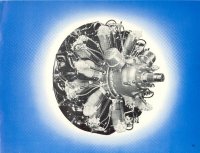
Pratt & Whitney Twin Wasp E
(Kimble D. McCutcheon) |
Pratt & Whitney’s last piston engine, the Twin Wasp E, combined all it had learned from the R-2800 and R-4360 programs into one elegant package. The Twin Wasp E kept the same bore and stroke that had been shared by its Double Wasp and Wasp Major ancestors. It used R-4360 style cylinders, with valve actuation fore and aft, but reversed the cylinder gas flow, with the intake port at the cylinder side and the exhaust port at the cylinder top. Crankshaft and crankcase construction was very similar to the R-2800, with a two-piece crankshaft and solid master rod housed in a three-piece power section split along the cylinder row centers.
The Twin Wasp E first ran on 25 Sep 1945 and was first shipped on 31 Jan 1949. Despite its advanced technology, the engine came along at the beginning of the jet age and there were few buyers. It powered the Svenska Aeroplan Aktiebolaget (SAAB) 90 Scandia airliner and the Piasecki XH-16/YH-16 helicopter prototypes, which were later converted to Allison turboshaft power. Only 75 Twin Wasp E engines were built before production ceased in 1951. |






















